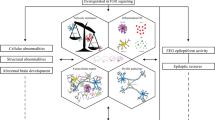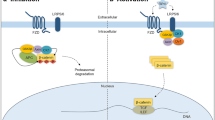Abstract
Mammalian target of rapamycin (mTOR) signaling has been shown to be deregulated in a number of genetic, neurodevelopmental disorders including Tuberous Sclerosis Complex, Neurofibromatosis, Fragile X, and Rett syndromes. As a result, mTOR inhibitors, such as rapamycin and its analogs, offer potential therapeutic avenues for these disorders. Some of these disorders—such as Tuberous Sclerosis Complex—can be diagnosed prenatally. Thus, prenatal administration of these inhibitors could potentially prevent the development of the devastating symptoms associated with these disorders. To assess the possible detrimental effects of prenatal rapamycin treatment, we evaluated both early and late behavioral effects of a single rapamycin treatment at embryonic day 16.5 in wildtype C57Bl/6 mice. This treatment adversely impacted early developmental milestones as well as motor function in adult animals. Rapamycin also resulted in anxiety-like behaviors during both early development and adulthood but did not affect adult social behaviors. Together, these results indicate that a single, prenatal rapamycin treatment not only adversely affects early postnatal development but also results in long lasting negative effects, persisting into adulthood. These findings are of importance in considering prenatal administration of rapamycin and related drugs in the treatment of patients with neurogenetic, neurodevelopmental disorders.





Similar content being viewed by others
References
Anderl S, Freeland M, Kwiatkowski DJ, Goto J (2011) Therapeutic value of prenatal rapamycin treatment in a mouse brain model of tuberous sclerosis complex. Hum Mol Genet 20(23):4597–4604
Benjamin D, Colombi M, Moroni C, Hall MN (2011) Rapamycin passes the torch: a new generation of mTOR inhibitors. Nat Rev Drug Discov 10(11):868–880
Bove J, Martinez-Vicente M, Vila M (2011) Fighting neurodegeneration with rapamycin: mechanistic insights. Nat Rev Neurosci 12(8):437–452
Buitrago MM, Schulz JB, Dichgans J, Luft AR (2004) Short and long-term motor skill learning in an accelerated rotarod training paradigm. Neurobiol Learn Mem 81(3):211–216
Chu SH, Liu KL, Chiang YJ, Wang HH, Lai PC (2008) Sirolimus used during pregnancy in a living related renal transplant recipient: a case report. Transplant Proc 40(7):2446–2448
Clancy B, Darlington RB, Finlay BL (2001) Translating developmental time across mammalian species. Neuroscience 105(1):7–17
Dash PK, Orsi SA, Moore AN (2006) Spatial memory formation and memory-enhancing effect of glucose involves activation of the tuberous sclerosis complex-mammalian target of rapamycin pathway. J Neurosci 26(31):8048–8056
Datta AN, Hahn CD, Sahin M (2008) Clinical presentation and diagnosis of tuberous sclerosis complex in infancy. J Child Neurol 23(3):268–273
De Vries PJ (2010) Neurodevelopmental, psychiatric, and cognitive aspects of tuberous sclerosis complex. In: Kwiatkowski DJ, Whittemore VH, Thiele EA (eds) Tuberous sclerosis complex: genes, clinical features, and therapeutics. Wiley, Weinheim, pp 229–267
de Vries PJ, Hunt A, Bolton PF (2007) The psychopathologies of children and adolescents with tuberous sclerosis complex (TSC): a postal survey of UK families. Eur Child Adolesc Psychiatry 16(1):16–24
Ehninger D, Silva AJ (2011a) Increased levels of anxiety-related behaviors in a Tsc2 dominant negative transgenic mouse model of tuberous sclerosis. Behav Genet 41(3):357–363
Ehninger D, Silva AJ (2011b) Rapamycin for treating Tuberous sclerosis and Autism spectrum disorders. Trends Mol Med 17(2):78–87
Ehninger D, Han S, Shilyansky C, Zhou Y, Li W et al (2008) Reversal of learning deficits in a Tsc2+/− mouse model of tuberous sclerosis. Nat Med 14(8):843–848
Framarino dei Malatesta M, Corona LE, De Luca L, Rocca B, Manzia TM et al (2011) Successful pregnancy in a living-related kidney transplant recipient who received sirolimus throughout the whole gestation. Transplantation 91(9):e69–e71
Franz DN, Leonard J, Tudor C, Chuck G, Care M et al (2006) Rapamycin causes regression of astrocytomas in tuberous sclerosis complex. Ann Neurol 59(3):490–498
Goorden SM, van Woerden GM, van der Weerd L, Cheadle JP, Elgersma Y (2007) Cognitive deficits in Tsc1+/− mice in the absence of cerebral lesions and seizures. Ann Neurol 62(6):648–655
Heyser CJ (2004) Assessment of developmental milestones in rodents. Curr Protoc Neurosci Chapter 8 Unit 8 18
Holmes A, Hollon TR, Gleason TC, Liu Z, Dreiling J et al (2001) Behavioral characterization of dopamine D5 receptor null mutant mice. Behav Neurosci 115(5):1129–1144
Kelleher RJ 3rd, Bear MF (2008) The autistic neuron: troubled translation? Cell 135(3):401–406
Krueger DA, Care MM, Holland K, Agricola K, Tudor C et al (2010) Everolimus for subependymal giant-cell astrocytomas in tuberous sclerosis. N Engl J Med 363(19):1801–1811
Kwon CH, Luikart BW, Powell CM, Zhou J, Matheny SA et al (2006) Pten regulates neuronal arborization and social interaction in mice. Neuron 50(3):377–388
Laplante M, Sabatini DM (2012) mTOR signaling in growth control and disease. Cell 149(2):274–293
Meikle L, Talos DM, Onda H, Pollizzi K, Rotenberg A et al (2007) A mouse model of tuberous sclerosis: neuronal loss of Tsc1 causes dysplastic and ectopic neurons, reduced myelination, seizure activity, and limited survival. J Neurosci 27(21):5546–5558
Meikle L, Pollizzi K, Egnor A, Kramvis I, Lane H et al (2008) Response of a neuronal model of tuberous sclerosis to mammalian target of rapamycin (mTOR) inhibitors: effects on mTORC1 and Akt signaling lead to improved survival and function. J Neurosci 28(21):5422–5432
Nie D, Di Nardo A, Han JM, Baharanyi H, Kramvis I et al (2010) Tsc2-Rheb signaling regulates EphA-mediated axon guidance. Nat Neurosci 13(2):163–172
Prather P, de Vries PJ (2004) Behavioral and cognitive aspects of tuberous sclerosis complex. J Child Neurol 19(9):666–674
Roubertoux PL, Bichler Z, Pinoteau W, Jamon M, Seregaza Z et al (2006) Pre-weaning sensorial and motor development in mice transpolygenic for the critical region of trisomy 21. Behav Genet 36(3):377–386
Scattoni ML, Gandhy SU, Ricceri L, Crawley JN (2008) Unusual repertoire of vocalizations in the BTBR T+ tf/J mouse model of autism. PLoS One 3(8):e3067
Tsai P, Sahin M (2011) Mechanisms of neurocognitive dysfunction and therapeutic considerations in tuberous sclerosis complex. Curr Opin Neurol 24(2):106–113
Tsai PT, Hull C, Chu Y, Greene-Colozzi E, Sadowski AR et al (2012) Autistic-like behaviour and cerebellar dysfunction in Purkinje cell Tsc1 mutant mice. Nature 488(7413):647–651
Tworetzky W, McElhinney DB, Margossian R, Moon-Grady AJ, Sallee D et al (2003) Association between cardiac tumors and tuberous sclerosis in the fetus and neonate. Am J Cardiol 92(4):487–489
Uhlmann EJ, Wong M, Baldwin RL, Bajenaru ML, Onda H et al (2002) Astrocyte-specific TSC1 conditional knockout mice exhibit abnormal neuronal organization and seizures. Ann Neurol 52(3):285–296
Wander SA, Hennessy BT, Slingerland JM (2011) Next-generation mTOR inhibitors in clinical oncology: how pathway complexity informs therapeutic strategy. J Clin Invest 121(4):1231–1241
Way SW, McKenna J 3rd, Mietzsch U, Reith RM, Wu HC et al (2009) Loss of Tsc2 in radial glia models the brain pathology of tuberous sclerosis complex in the mouse. Hum Mol Genet 18(7):1252–1265
Way SW, Rozas NS, Wu HC, McKenna J 3rd, Reith RM et al (2012) The differential effects of prenatal and/or postnatal rapamycin on neurodevelopmental defects and cognition in a neuroglial mouse model of tuberous sclerosis complex. Hum Mol Genet 21(14):3226–3236
Yang M, Silverman JL, Crawley JN (2011) Automated three-chambered social approach task for mice. Curr Protoc Neurosci Chapter 8 Unit 8 26
Yuan E, Tsai PT, Greene-Colozzi E, Sahin M, Kwiatkowski DJ et al (2012) Graded loss of tuberin in an allelic series of brain models of TSC correlates with survival, and biochemical, histological and behavioral features. Hum Mol Genet 21(19):4286–4300
Zeng LH, Xu L, Gutmann DH, Wong M (2008) Rapamycin prevents epilepsy in a mouse model of tuberous sclerosis complex. Ann Neurol 63(4):444–453
Acknowledgments
We thank Michela Fagiolini, Paul Rosenberg, and Jacqueline Crawley for assistance with behavioral experiments. P. T. T. received support from the Developmental Neurology Training Grant (T32 NS007473), American Academy of Neurology, and the Nancy Lurie Marks Family Foundation. This work and M. S. are supported by the John Merck Scholars Fund, Boston Children’s Hospital Translational Research Program, and Boston Children’s Hospital Intellectual and Developmental Disabilities Research Center (P30 HD18655). DJK was supported by NIH NINDS 2R37NS031535-14.
Author information
Authors and Affiliations
Corresponding author
Additional information
Edited by Pierre Roubertoux.
Peter T. Tsai and Emily Greene-Colozzi contributed equally to this study.
Rights and permissions
About this article
Cite this article
Tsai, P.T., Greene-Colozzi, E., Goto, J. et al. Prenatal Rapamycin Results in Early and Late Behavioral Abnormalities in Wildtype C57Bl/6 Mice. Behav Genet 43, 51–59 (2013). https://doi.org/10.1007/s10519-012-9571-9
Received:
Accepted:
Published:
Issue Date:
DOI: https://doi.org/10.1007/s10519-012-9571-9




